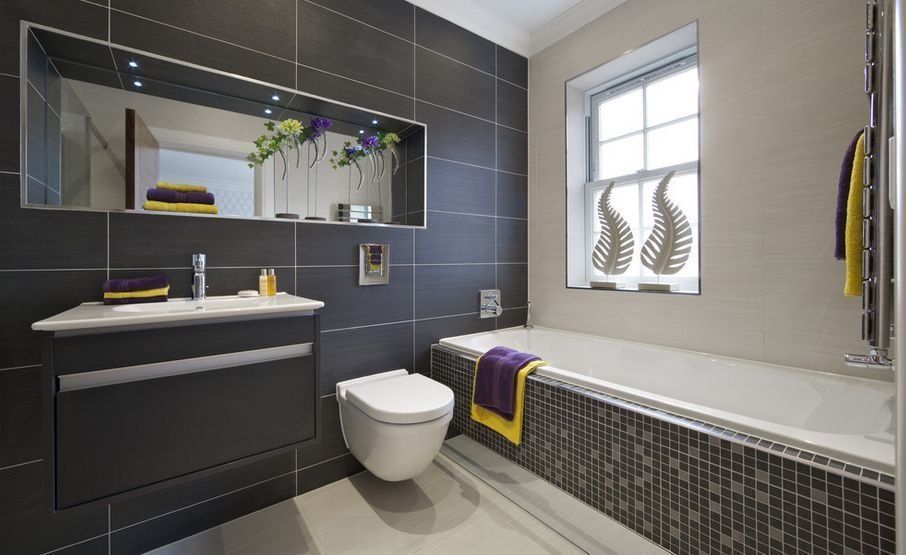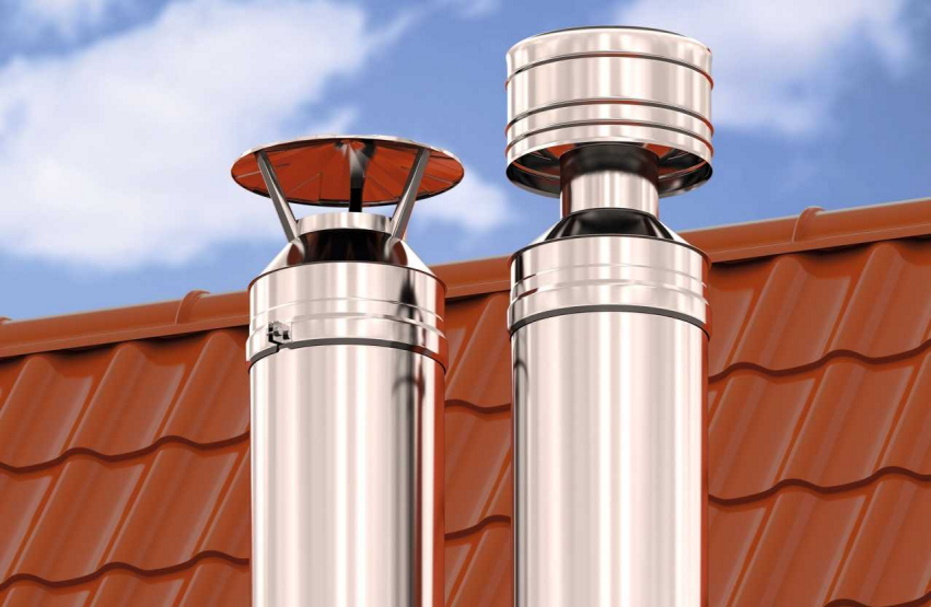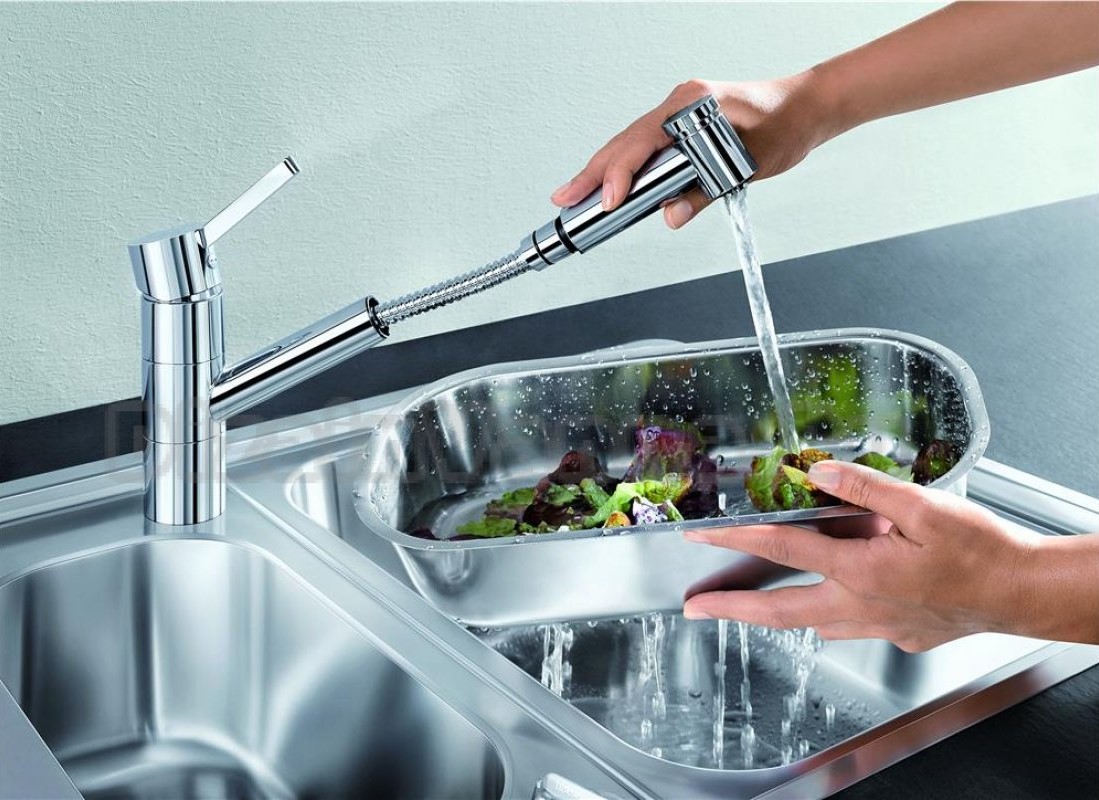Ranking of the most expensive dog breeds for 2022

It is not in vain that the well-known phrase “We are responsible for those we have tamed” sounds. This is true, because before you get the desired pet, you should carefully weigh the pros and cons. Having brought a puppy they liked into the house, and after a while deciding that it does not fit into the daily rhythm of life of its inhabitants, the owners deal an irreparable blow to it, returning it back to the shelter or nursery. That is why, before taking a pet, it is necessary to answer 11 simple questions and only according to the answers received, select the appropriate breed.

Content [Hide]
Preliminary sketch of the breed
So, the following is a detailed list of questions that are recommended to be answered honestly by all family members who are interested, and subsequently taking part in the upbringing and life of a pet:
- What is the purpose of buying a puppy?
- What temperament pet is closest to future owners?
- What should be the size of the ward?
- Should the dog be owner or service oriented?
- Is the smooth-haired or long-haired breed preferred?
- Should an individual participate in breeding or not?
- What gender should the pet be?
- What is the amount of the purchase?
- What should be the age of the puppy?
- Who are the family members?
- Where is the purchase planned?
After answering the questions presented, it is recommended to study the information on each of the points in more detail.
Purpose of getting a dog
According to their purpose, all four-legged animals are conditionally divided by cynologists into 6 categories:
- Service;
- Sports and service;
- hunting;
- Sports and hunting;
- Sports and decorative;
- Room-decorative.
From the names it is already possible to draw a preliminary conclusion about the purposes for which this or that individual was bred.
So, dogs with the prefix "sports-" are more versatile species, as they are both focused on the owner and will become his indispensable companion on walks and hikes. But even such representatives have their own individual characteristics and character traits.
If the dog is intended for guarding the house and the site, hunting, as well as working with a herd of domestic animals, then hunting or sports and hunting types should be preferred. Such pets will be companions to the owners, understanding them even from a half-word or glance.
If a puppy is purchased for official purposes, then a breed with the appropriate characteristics should be preferred. These animals are more distrustful of strangers, aggressive, but clearly focused on the owner's commands.
If the pet is destined to show off in the home interior and on the backyard lawn, then indoor and sports-decorative views will come in handy.
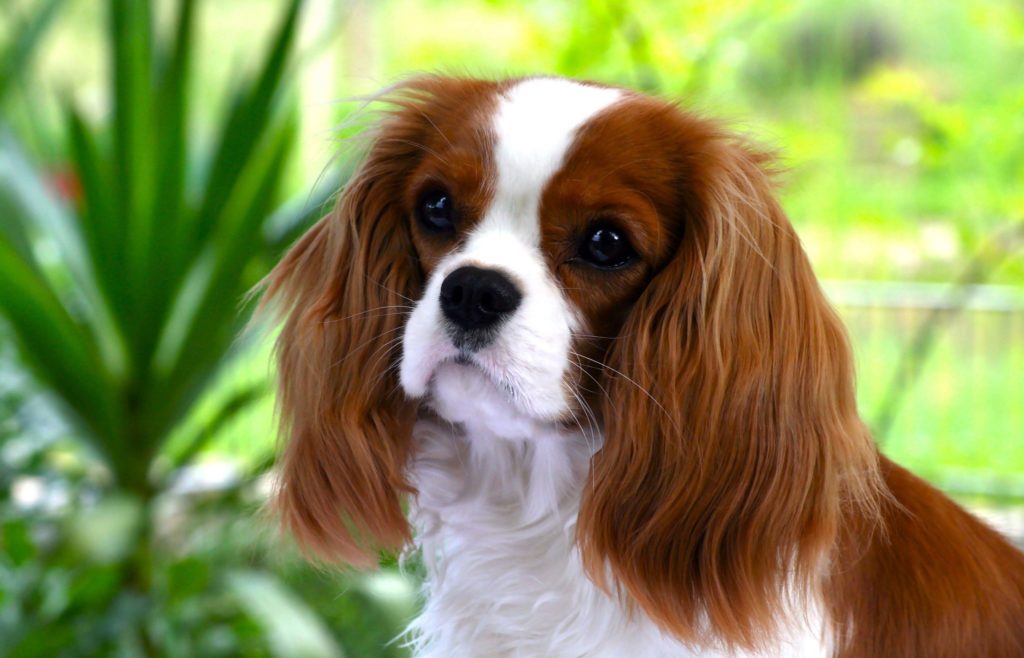
The attention of the owner is of great importance for a pet. The amount of time that the owner can devote to his pet depends on his psychological state, mood and behavior. It also plays an important role in choosing the right type.
Temperament
Temperamentally, quadrupeds are no different from humans. They may also be:
- choleric;
- sanguine;
- phlegmatic;
- melancholic.
They differ from a person in that their mobility directly depends on temperament. Animals belonging to the first category are very mobile, love to run and play. If you do not give them such an opportunity, then their mood quickly deteriorates and flight from a limited territory is not excluded.
Individuals of the second group are not as active as the first: they are not so often subject to sudden changes in mood and behavior.
Phlegmatic pets only in puppyhood and adolescence are prone to active outdoor games. As they get older, this entertainment is less and less to their liking.They have practically no sharp mood swings that lead to appropriate behavior. This does not cause any trouble for the owners.
Melancholic dogs, like people belonging to this category, love home comfort and can spend a long time without active entertainment and walks. But such pets have a significant drawback, which can even lead to illness. This is a lack of attention from a beloved owner. With a long absence, the animal is very bored, refuses to eat for weeks, which can cause the disease.
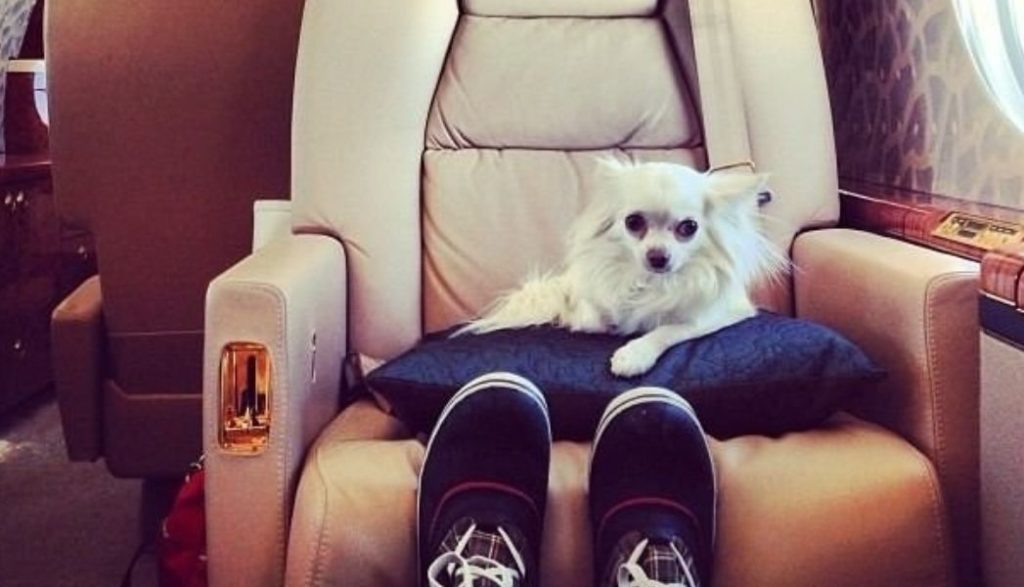
The size
It is impossible to neglect this criterion for choosing a pet, because not all animals are able to respond normally to the restriction of their space. Like a person, a puppy may develop various types of phobias if the necessary conditions for their maintenance and life are not provided. Failure to comply with them may well lead to nervous breakdowns, therefore, based on the space provided at the disposal of the dog, you can choose a dog of large, medium or small size.
For a private house with a spacious backyard, representatives of large and medium breeds are perfect. For multi-storey buildings with small apartments, the best option would be dogs of a room-decorative look. But there are exceptions in large dogs, which calmly endure a limited space. These are phlegmatic, melancholic and some sanguine dogs. These include Leonbergers and Mountain Dogs.
Owner orientation
According to their orientation towards people, cynologists divided animals into 3 groups:
- companion dogs;
- owner oriented;
- indifferent.
For living in city apartments and houses with a large number of people or family members, companion dogs are the best. They get along well with everyone around them and quite obediently follow the commands they hear. Dogs with a focus on the owner also perform well in this capacity, because in the bustle of the city it is necessary that the pet walking next to the owner impeccably follow the orders given by the owner in order to avoid any accidental negative consequences.
The third group of animals is the least suitable for such a life. It mainly includes all northern sled dogs, which carry out a clear command only if they like it, otherwise they simply ignore it.
Wool
This item should also be given due attention, since it is wool that can cause frequent and thorough cleaning of the premises, washing and caring for clothes, the occurrence of allergic reactions, more regular care of the pet's coat.
That is why it should be remembered that the long, soft and silky to the touch coat of a dog needs careful daily care, combing and so on, which inevitably leaves its marks on all pieces of furniture and interior of an apartment or house.
Smooth and short hair, on the contrary, is minimal in care, but its short hairs, like small needles, penetrate all clothes and other fabrics, which causes some discomfort to people around.
Pets that have a thick undercoat can, for the most part, cause an allergic reaction. Therefore, people prone to such manifestations need to be careful in choosing such breeds.
To participate or not to breed
Buying a dog of an expensive breed in a specialized kennel makes it possible to acquire not only a purebred pet, but also imposes certain obligations on the owner. They consist in the fulfillment of the clauses of the contract signed by the seller and the future owner, which obliges the buyer to take part with the acquired puppy in organized official exhibitions. Only such dogs are allowed for breeding.
If these points are refused, then others, stipulated in the contract, consisting in the mandatory sterilization or castration of the acquired individual, can certainly come into force in order to exclude self-breeding of the breed.
Giving consent to the participation of the animal in exhibitions, the owner assumes the obligation to prepare the puppy for them, which is a very costly task both financially and temporarily.
Buying a non-show animal from a cattery can be much cheaper.
"Girl or boy"
Here you should approach the choice not from the point of view of breeding, but look at the character of the female and the male. Dogs, like men, have the trait of leadership in the family, so they are more zealous in sorting out the relationship between their fellows, and are also distinguished by a more ardent attempt to take the place of a leader in a foster environment. If they succeed, then subsequently the whole life of the people around will be tied only to this pet. That is why you should not miss the right moment and show the dog who is the boss in the house.
Females are more accommodating, but at the same time more cunning. Their role is to become a leader among the female part of the inhabitants of the family. They try to be as close as possible to the owner of the house, considering him the leader, and to win precisely his favor.But, if the family consists of only women, then such individuals may try to take a leading position in it, counting on the complete subordination of the rest of the members.
Financial and labor costs
It logically follows that by acquiring a purebred pedigreed individual, the owner undertakes to strictly follow the rules of care, nutrition, treatment and many other accompanying procedures. It has long been known that the older the history of a pet breed, the more picky it is about food and the more prone to all kinds of diseases. In an ordinary veterinary clinic, such a dog will not be treated, since there are specialized hospitals for this. Food must also correspond to proper and healthy nutrition, which does not harm either the pet's health or its coat, claws, etc. Also, monthly haircuts, nail trimming, oral care, teeth, hair, vaccinations and other procedures can cost the owner a considerable amount.
In addition to financial investments, quite a lot of effort will have to be made to prepare the animal for participation in exhibitions (if agreements are reached on this matter when signing the contract in the nursery).
They consist in:
- visiting various salons;
- classes and trainings;
- examinations and preparations;
- selection of accessories and tailoring of appropriate clothes;
- direct participation in the exhibition and awarding.
That is why, if you want to buy a thoroughbred pet, you should not discount such an important clause of the contract as breeding.
Age
For the most part, future owners prefer small fluffy and funny puppies, but before that you should think about whether any of the family members can give the “baby” as much attention as he needs at that age, because he has not yet been accustomed to a certain a place for waste products, can be naughty and spoil surrounding objects, get nervous if he feels abandoned and lonely. If such conditions cannot be provided, then in this case it would be preferable to take a grown puppy.
This option is also more suitable for those people who decide to get a pet for the first time and do not have experience in caring for small offspring.
Family Composition
An important factor determining the type and size of the dog is the age of the family members where the puppy will live. If there are small children in it, then it is advisable to give preference to larger individuals. And it is right. Due to their natural dominance, dogs try to prove it. Individuals of small breeds may perceive the baby as a competitor and will behave more aggressively with him. Large animals in this case do not see an opponent in the face of a small child and treat him more condescendingly. The second reason why you should not bring the same pets to a house with young children is the uncontrollability of their actions by the kids. Due to their negligence or ignorance, they can harm the health of the pet.
Also, small dogs should not be placed in rooms with older people. Due to the weakness of vision, as well as limited movement, they can trip over the animal and injure it.To avoid this, it is better to purchase an individual of medium or large size in the house.
Place of purchase
Depending on how much finance is planned to be spent on acquiring a pet, as well as what the purpose of the purchase is, it can be carried out in one of the nurseries.
In a specialized and expensive one, it is not always possible to choose a pet without problems and unnecessary questions. Not every one of them will agree to give away a purebred pedigreed representative without the possibility of breeding, so many issues from the sale and purchase agreement will have to be negotiated, discussed and, possibly, changed.
In less picky kennels, you can get a cheaper puppy, maybe not quite a purebred, but eating simple food and not so sickly.
On numerous forums on the Internet, you can also find ads for the sale of unscheduled puppies of the required breed.
If there is no money to buy a dog, but there is a great desire to have one, then you can contact any animal shelter and choose a real friend there for free.
Ranking of the most expensive dog breeds for 2022
According to experts participating in numerous exhibitions of thoroughbreds, the following breeds are considered the most expensive for 2022.
Large breed dogs
Canadian eskimo dog
votes 3
Representatives of this breed with a height of 61 to 73 cm weigh 20-40 kg. Life expectancy is 12-14 years. The Canadian Eskimo Dog is critically endangered. These dogs are distinguished by great strength, courage, endurance and devotion. To stay in good physical shape, they need prolonged exercise.
By nature, representatives are calm, easy to make contact and get along well with all family members.In relation to young children, they can behave in two ways. If the fluffy pet is given as much attention as the baby, then he will not have feelings of jealousy. If he lacks one, then such a character trait may well be present. The beast will quickly make friends with school-age children and become not only a friend, but also a reliable protector.
This type treats strangers with distrust, but, thanks to innate curiosity, it can become interested in them and even show friendliness.
For the most part, representatives of the Canadian Eskimo are non-aggressive, sociable and make good contact, but if they do not meet reciprocity, they themselves can show aggression.
These dogs lend themselves well to training, but it is better to entrust this process to experienced dog handlers.
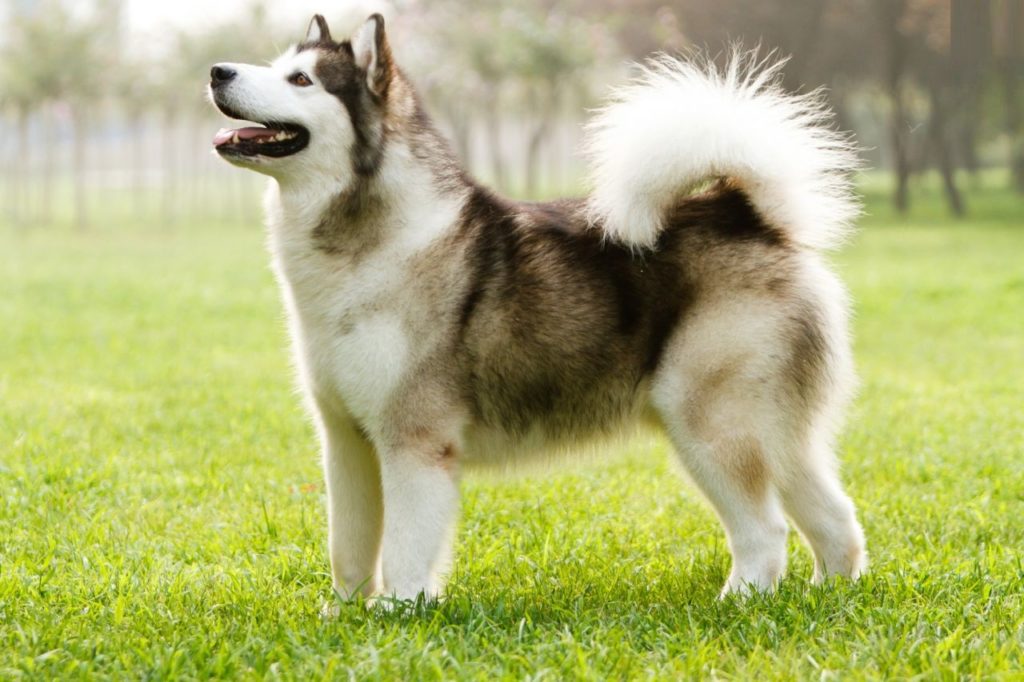
The optimal content of such a representative would be a private house with a plot where the pet will be given the opportunity to run and exercise. Although the possibility of his stay in the apartment is also not ruled out, then a daily walking with jogging and physical activity will be a necessary condition.
It is important to know that the Canadian Eskimo Sheds twice a year, in spring and autumn. At this time, it must be combed out 2 times a week with a special device. In other cases, a single procedure in 7 days is sufficient.
- bold;
- strong;
- reliable;
- friendly;
- sociable.
- possible feeling of jealousy;
- there is aggression towards relatives.
french mastiff
votes 5
The standards for representatives of this type are as follows:
- height at the withers: 60-70 cm;
- short, broad wrinkled muzzle;
- large head with a flat forehead;
- strongly saggy lips;
- small, thin ears;
- thick neck;
- massive chest;
- red or yellow-brown color;
- short and thick coat.
The French Mastiff or Dogue de Bordeaux differs from other breeds in its squat and at the same time muscular body. An erroneous "dissatisfied" expression of the muzzle can mislead buyers, but in fact, these individuals are very friendly, and besides, they are phlegmatic. That is why there is no aggression on her part. An exception is a threat to the health or life of the owner or the animal itself.
Long considered the favorites of the richest people, by the will of fate, many purebred French mastiffs died during the next revolution along with their owners. The remaining individuals, mixing with representatives of other species, have lost most of their potential qualities, such as bloodthirstiness and ferocity. They were often told in epics and legends.
Modern mastiffs are not like that at all. Despite the feigned menacing expression of the muzzle, they are very affectionate, friendly and devoted animals at heart. This is one of the breeds that is very difficult to endure separation from the owner, so this pet is not suitable for those who often go on long business trips.
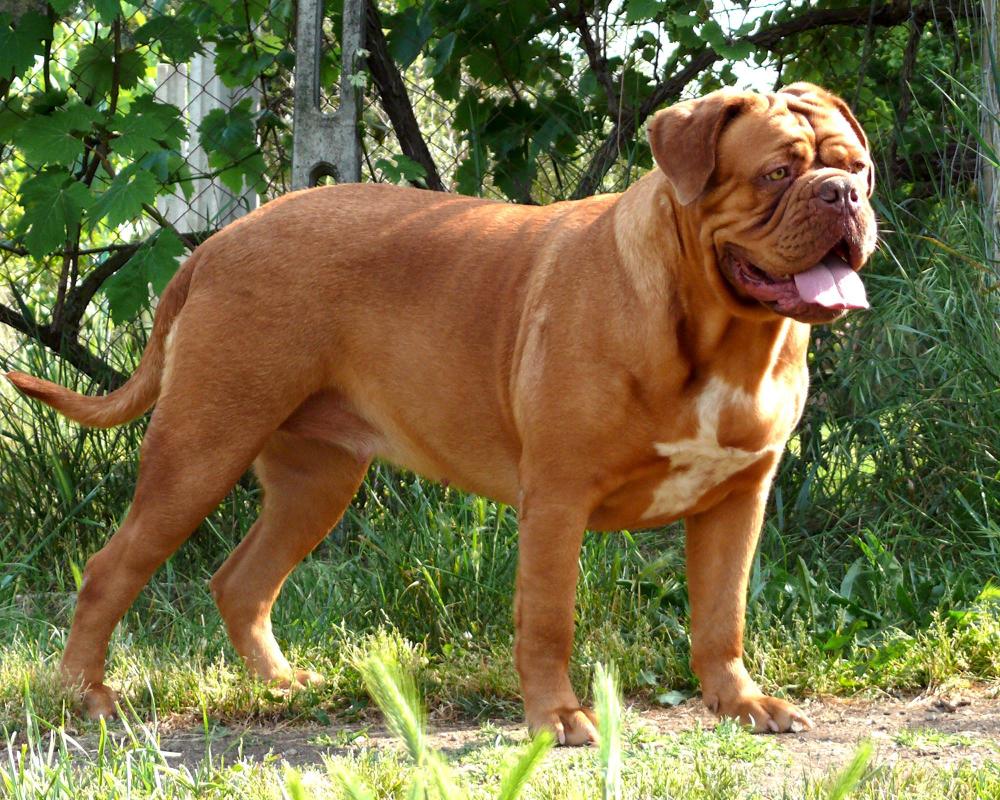
He is not at all aggressive and can let a stranger close enough, but if there are distinct attempts of provocation or aggression in the actions of a stranger, he will immediately receive a powerful rebuff.
In any house, the mastiff will find a common language with all the inhabitants up to the cat, but the presence of a dog of any fighting breed will provoke a showdown.
The rather ferocious appearance of the animal does not in the least prevent him from doing an excellent job as a caring nanny for kids and becoming a real friend for older children.
Due to their belonging to the phlegmatic group, daily jogging is not so important, and cynologists recommend training exercises, taking into account the natural laziness and rapid fatigue of the dog. It is also recommended not to overload mastiffs, both adults and puppies, with intense and prolonged exercise. They are simply contraindicated. A feature of this type is high mental intelligence, so its representatives understand all the teams perfectly.
With a short and smooth coat, the Dogue de Bordeaux does not require frequent grooming. It is enough to periodically comb it out with a rubber glove. Harder devices for this procedure are not suitable, as they can injure the dog's skin itself, but its muzzle requires daily, thorough washing and cleaning. This is due to the presence of numerous wrinkles and folds in which dirt and debris accumulate, so frequent washing will avoid some of the diseases inherent in this type, namely the occurrence of allergic reactions. French Mastiffs are also prone to hip dysplasia and some types of cancer.
- good-natured;
- non-aggressive;
- phlegmatic;
- does not require active rest;
- a good nanny and friend;
- faithful;
- does not require constant care, except for the muzzle.
- not identified.
tibetan mastiff
votes 6
A magnificent huge handsome man with his appearance resembles the king of beasts. But not only in appearance they are similar, but also in their generosity and calmness.
The breed standards are as follows:
- height: male from 66 cm;
- female from 61 cm;
- weight from 64 to 78 kg;
- live for 10-11 years;
- heavy and strong head fits perfectly with the rest of the body;
- a fairly pronounced tubercle on the back of the head (a feature of the breed);
- a wide muzzle, the full face of which is a square;
- broad nose with large black or dark brown nostrils;
- lips fleshy, close fitting to the lower jaw;
- in adult dogs, folds on the sides of the muzzle are acceptable;
- ears are small triangular in shape, slightly falling forward;
- eyes slightly slanted and wide-set, with a brownish tint (the saturation of the shade indicates the quality of the breed);
- strong jaws with teeth in a scissor or level bite;
- the massive neck has a pronounced scruff, which is more pronounced in males;
- strong and heavy body with a heart-shaped sternum;
- the tail, like the mane, is of medium length, strongly pubescent;
- the elbows of the forelimbs are directed strictly back (the direction of those inward or sideways indicates the marriage of the breed);
- hard and straight coat with thick undercoat;
- the main color of the breed: golden with all sorts of shades - sable, black, black and tan, blue.
The Tibetan Mastiff is a majestic, calm and balanced animal with unique natural instincts. This also applies to the protection of the territory entrusted to him. Intuitively foreseeing even the slightest threat or danger, the dog will meet her fully armed. Preferring a nocturnal lifestyle, it is not surprising that at a later time others can be awakened by a lion-like roar or a frightening loud bark. That is why you should be prepared for such a turn of events.
The Mastiff is not afraid of strangers and will calmly let them approach him or his owner, but a stranger should not relax, because a gaze will not disregard even the slightest of his movements.
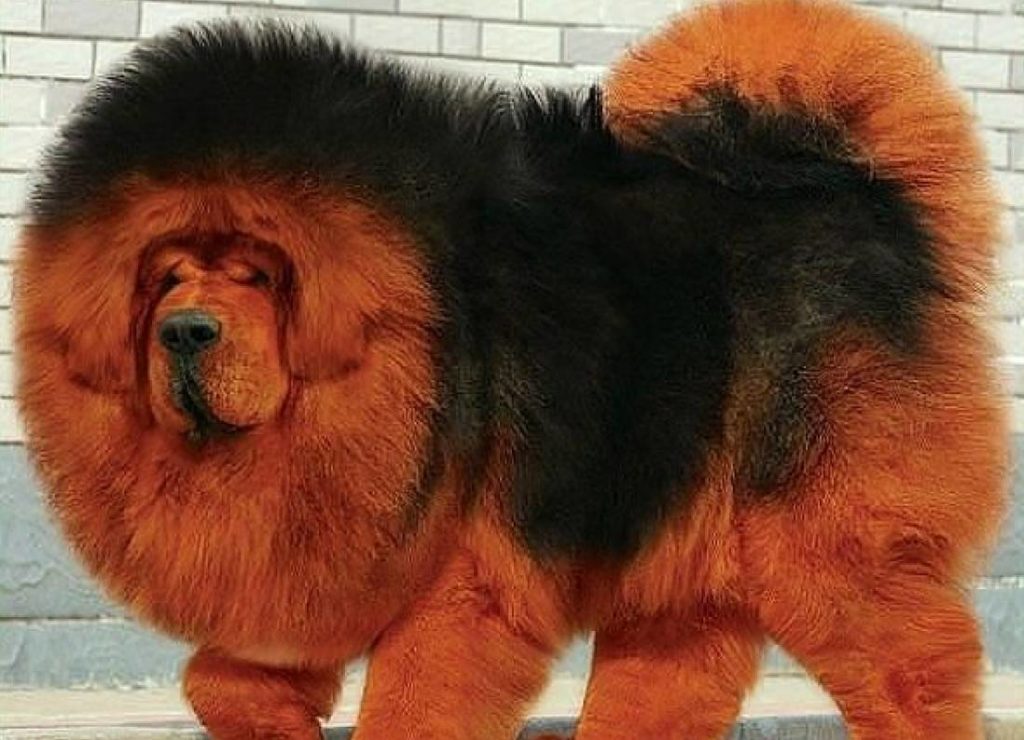
Noisy companies and guests also do not like the majestic representative of the ancient species. Too frisky movements of strangers can be perceived by him as a threat to residents. The dog will immediately make an attempt to calm the dispersed or will try to reduce the number of visits to the house. The same situation can arise with children playing noisily in the room. The animal will immediately come to the defense of its little owner and can, with its powerful body, cause significant harm to the health of other children.
The dominant position of this type will not allow any of the pets to be higher than its representatives. An exception may even be cats that lived and grew up with a puppy from a very young age. When there is already a Tibetan mastiff in the house, it is not recommended to start other dogs, otherwise conflicts are inevitable.
Adult representatives of this species are very calm and majestic, with their own sense of dignity, but puppyhood can bring a lot of trouble. In the absence of the necessary upbringing, left without due attention in a matter of minutes, they will smash everything that gets in their way, so feelings of boredom in mastiff puppies should not be allowed.
Since this variety is difficult to train, it is better to leave this process to professionals, and within two years the pet will learn to understand and also carry out the necessary commands. If you do it yourself, you will have to stock up on remarkable patience and tact in order to achieve at least some results. In no case should rudeness and force be allowed during training, otherwise a huge “problem” will grow out of a small puppy and it will no longer be possible to fix it.
One of the important factors influencing the behavior of the Tibetan Mastiff in society is its socialization. This should be done at an early stage of growth and education of the puppy. It is better to start from the seventh week of life, which will allow the animal to be more tolerant and calm towards the surrounding people and their wards.
Caring for these representatives is not as difficult as that of other species, but still requires some effort. It consists in:
- combing wool with a metal brush 3 times a week;
- removing tangles (if any);
- bath day 1 time in 3 months;
- shortening the claws once a month and carrying out related procedures;
- brushing your teeth twice a week;
- rubbing the ears and eyes once a week;
- constant monitoring of the composition of food (it is not recommended to combine solid and natural food in order to avoid problems with the digestive system);
- regular visits to the veterinary clinic.
- calm;
- balanced;
- good-natured;
- reliable defender;
- sensitive natural instincts.
- likes to dominate;
- excessive noise causes aggression;
- in puppyhood does not like loneliness.
English bulldog
votes 8
Representatives of this type are truly considered the oldest in England. Adapting to the laws of the times, requiring changes, they had to be reborn from ferocious bull-baiting fighters into benevolent and phlegmatically imposing companion dogs of the wealthy bourgeoisie. The tireless work of breeders on the reincarnation and improvement of the variety has led to the popularization of the almost extinct type of English bulldog.
The standard parameters of bulldogs are:
- height: males - 50-55 cm;
- females - 50-53 cm;
- weight, respectively, 25 and 23 kg;
- live an average of 8-10 years;
- a large massive head, proportionately combined with the rest of the body;
- thick, powerful neck with a noticeably curved scruff;
- short, wide muzzle with a massive jaw;
- pronounced undershot;
- flew on both sides of the muzzle, dense, covering most of the lower jaw;
- the nose is small, depressed, wide;
- the eyes are set wide apart and located at the maximum distance from the ears;
- dark eye color indicates belonging to purebred representatives;
- forepaws slightly turned outward;
- the coat is straight, short, soft and close fitting;
- the tail is set low;
- the color is monophonic, motley or smoot (solid-colored body and a dark muzzle or mask on it).
English Bulldogs are great companions for families with children, sedate noble couples or single people. It is not worth believing in a threatening appearance, a very good-natured and sympathetic animal is hiding behind it. Males can be a bit stubborn, females do not have this trait. This animal is calm, balanced, loyal, friendly, intelligent, focused and observant. In a word, a real gentleman.
These dogs will make a wonderful company for small children. With funny facial expressions, love for running and jumping, they take part in all outdoor games with great pleasure. But if you feel the slightest danger to your master, they will immediately turn into reliable and formidable defenders. Pets, along with the owners, are included in the “family” by bulldogs and peacefully coexist with each other.
After the rebirth of the variety, the dogs representing it became largely dependent on their owners. Any caress of family members in relation to pets responds with generous gratitude.
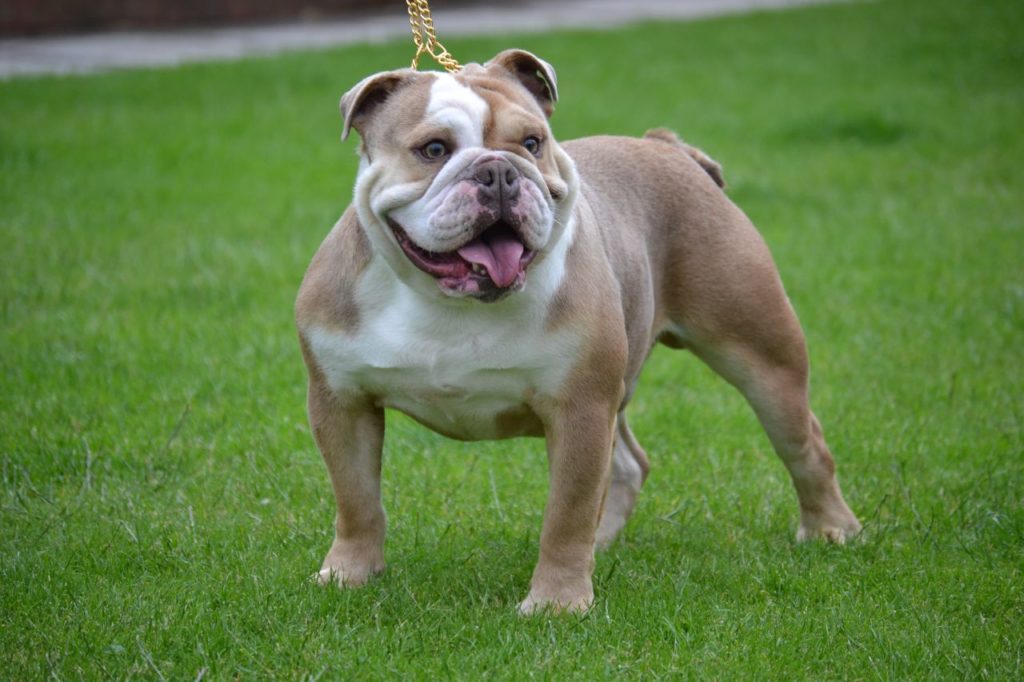
In order for a puppy to grow up healthy and happy from an early age, experts recommend paying special attention to the diet. Because the English Bulldog's hereditary weak organ is the pancreas, it should not be overloaded with fatty foods, and a carefully balanced solid and natural diet should also be given.
To maintain good physical shape, bulldogs do not need to torture themselves with excessive and prolonged loads. For the variety, a leisurely three-kilometer run is enough to keep all the muscles of the dog in good shape. Also, the rationale for preventing active physical exertion is the structure of the muzzle and respiratory system of the beast. When overloaded, the bulldog begins to breathe rapidly, which in his situation is unsafe.
It also greatly affects the labor activity of females. Without medical assistance, female English Bulldogs cannot give birth on their own, and if this happens in rare cases, then after the appearance of the first puppy, labor activity can completely stop. That is why experts recommend when buying a female puppy not for breeding, immediately sterilize it.
The most unusual trait of the English Bulldog is his reaction to a new situation that makes him nervous or stressed. One of them may be a car ride or unfamiliar and harsh sounds. In this case, the pet may lose some of the hair from the resulting nervous strain or stress, so this should not be taken as a disease. After adaptation, such signs gradually disappear.
Grooming English Bulldogs includes a set of standard procedures designed for shorthair types.It is recommended to bathe them as needed and preferably in clean water without the use of abrasive detergents. It will be more effective to regularly wipe the muzzle with napkins, since dogs of this species are characterized by profuse salivation.
With high intelligence and some stubbornness, these representatives do not always fully accept the process of training or training, choosing only what they like. It is for this reason that harsh measures or punishment for failure to comply with the voiced commands will not lead to anything good. An offended dog will not approach the owner for a long time, while using affection in the educational process, you can get excellent results.
Allergy is the most common disease among English Bulldogs. Basically, it is caused by improper selection of food. First of all, experts recommend revising it, and then looking for other reasons.
- smart;
- have the qualities of a "gentleman";
- caring and reliable;
- great companions and friends.
- touchy;
- do not like rudeness;
- require patience and affection in the process of training.
Akita Inu
votes 7
Smiling dog, as the representatives of the Akita Inu began to be called because of their unusual structure of the muzzle. They are considered the most ancient breed in Japan. For their guard services and beauty, they were close to the palace nobility and became privileged: no one dared to treat them disrespectfully or rudely. This continued until a new fashion trend appeared in Japan - dog fighting. So, strong and hardy Akita Inu began to be used in these bloody games. The former admiration for them quickly disappeared.
Then, during the war, where the Akita Inu were called, almost all were exterminated. Thanks to some descendants of the nobility who managed to keep their favorites, it was possible to increase the population of this species again.
An animal can be considered a standard Akita Inu specimen:
- height from 55 to 70 cm;
- weighing 23-40 kg;
- life expectancy - 10-15 years.
Him:
- large and strong physique;
- proportional head with triangular erect ears, slightly tilted forward;
- dark almond-shaped eyes with a raised outer angle;
- high-waisted fluffy tail twisted into a ring;
- hard, straight coat with a thick and soft undercoat;
- red, white or brindle.
Akitas are known among the people as the most faithful animals, capable of replacing a nanny for a small child on an equal basis with adults. Being a mobile and active animal, it requires daily long walks for at least half an hour. This species is distinguished by curiosity, willfulness and natural dominance, therefore, from puppyhood, cynologists recommend orienting the dog to the owner and the social environment. For people who decide to have a puppy for the first time, this type is not suitable. It is better to purchase it for owners who have experience in growing and raising such puppies.
Friendly and hospitable towards members of the Akita family, jealous and aggressive towards other household animals. In order to avoid conflicts on this basis, the owner must constantly keep the ward in control.
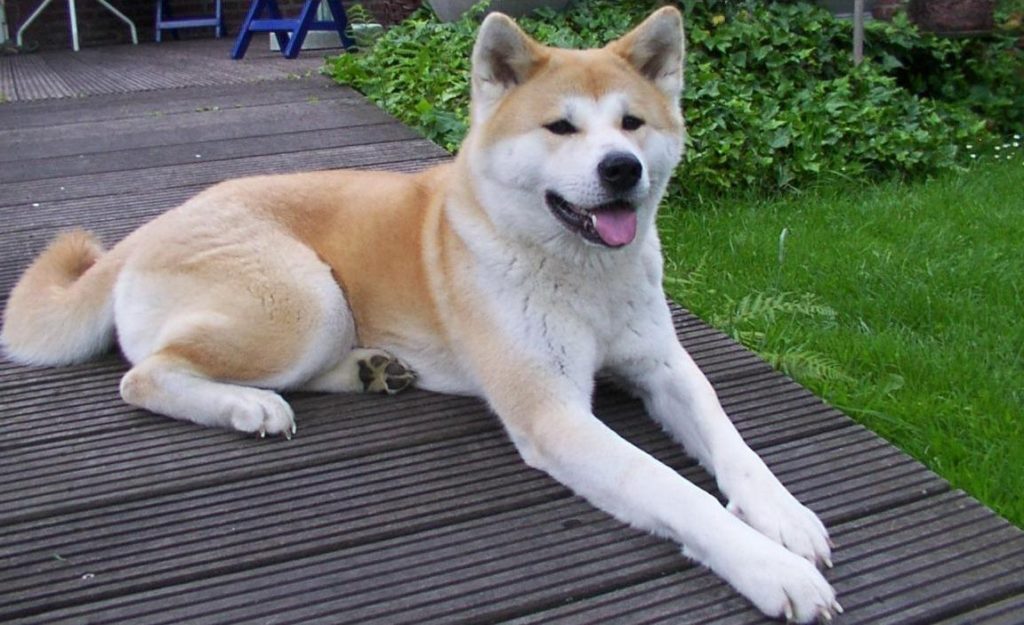
These dogs are universal, that is, they can live both in a small apartment and in a spacious private house. The main thing is not to leave your pet without proper attention.If this is not enough for the household, then he begins to get bored and show character (bark, get angry, gnaw at everything). By the way, the barking of this animal sounds very rare (mostly you can hear a growl, snort or grunt), so the Akita Inu is reputed to be a silent breed.
It's not hard to take care of her. Due to the fact that a dog can wash itself with its paws like a cat, it is recommended to arrange a bath day for it no more than 1 time in 3-4 months, but you will have to comb out beautiful wool 1 time per week. During molting, the procedure must be done daily.
In raising a puppy, it is better to show that he is a full member of the family, then the Japanese waywardness will not be infringed and there will be no limit to his gratitude, otherwise the natural stubbornness of the species will work and all training will be in vain.
In terms of health, this type is one of the strongest representatives, but there are 2 problems that may arise throughout the life of a pet. This is a disease of the joints and eversion or inversion of the eyelids. It will not be possible to solve the second problem on its own, so only a specialized clinic can help. To avoid joint diseases and other signs of discomfort in the form of bloating and possible intestinal volvulus, experts recommend carefully and carefully monitoring the diet.
- faithful;
- do well with children;
- silent;
- smart;
- benevolent;
- are in good health.
- wayward;
- stubborn.
Representatives of the middle segment
Saluki
votes 8
Salukis are true representatives of the Asian species. Due to their natural qualities, they easily tolerate heat, but are very intolerant of cold, so their craving for soft chairs, sofas and ottomans is very reasonable.
The apartment content of this species is unacceptable due to the physical activity of animals. For them, a house with a plot adjacent to it is more comfortable, where you can arrange a comfortable enclosure for a pet for the period of winter cold.
The standard representative of this type has:
- height from 58 to 71 cm;
- weight from 14 to 25 kg;
- life expectancy - 12-14 years;
- traditional pedigree wool with feathering on paws and ears (or smooth and short);
- aristocratic elongated head, narrowed towards the nose and expanded towards the ears with a slightly pronounced bridge of the nose;
- massive jaws with strong teeth forming an excellent scissor bite;
- flesh-brown or black nose of a standard shape;
- attentive, noble look of the eyes of the correct oval shape, the color of which can be from hazel to dark brown;
- large and long hanging ears, close fitting to the head, set high and covered with long hair;
- gracefully curved long neck with beautiful muscle relief;
- lean, but not fragile physique with a well-retracted belly;
- aristocratic long and strong paws with the original shape of the fingers, with which they can do little pranks in the form of opening refrigerators, doors, etc.;
- set low, almost at the level of the back, tail with a sparse dewlap;
- short and silky to the touch coat, smoothly turning on the back of the body into a long fringe;
- a wide range of colors, ranging from white to black in brown-red and brown tones (brindle is an exception).
Being graceful, lean and graceful animals with an independent and silent character, they will keep the company and become a tactful friend.Salukis will not bother their owners with demands for food or entertainment, but will calmly and unobtrusively wait for their time.
But when the hour of the walk comes, the animals have complete freedom, which must be totally controlled. Born hunters, seeing any small living creatures, perceive it as a victim and immediately begin hunting.
Unlike other types of dogs, Salukis are intolerant of children's pranks and will not fail to respond to them with aggression, so there are no nannies from them.
Due to the natural sensitivity of the nervous system, these animals cannot tolerate speech in raised tones. This applies not only to such an attitude directly towards them, but also between the owner and other people. Saluki, having got into a similar situation, try to leave as soon as possible and hide in some secluded place. If this is not possible, then gradually the graceful majestic pet turns into a miserable, torn animal, which subsequently will not respond normally to any exhortations.
Dogs of this species obey only one member of the family, but the rest are treated with a benevolent aristocratic look. The exceptions are complete strangers and their pets.
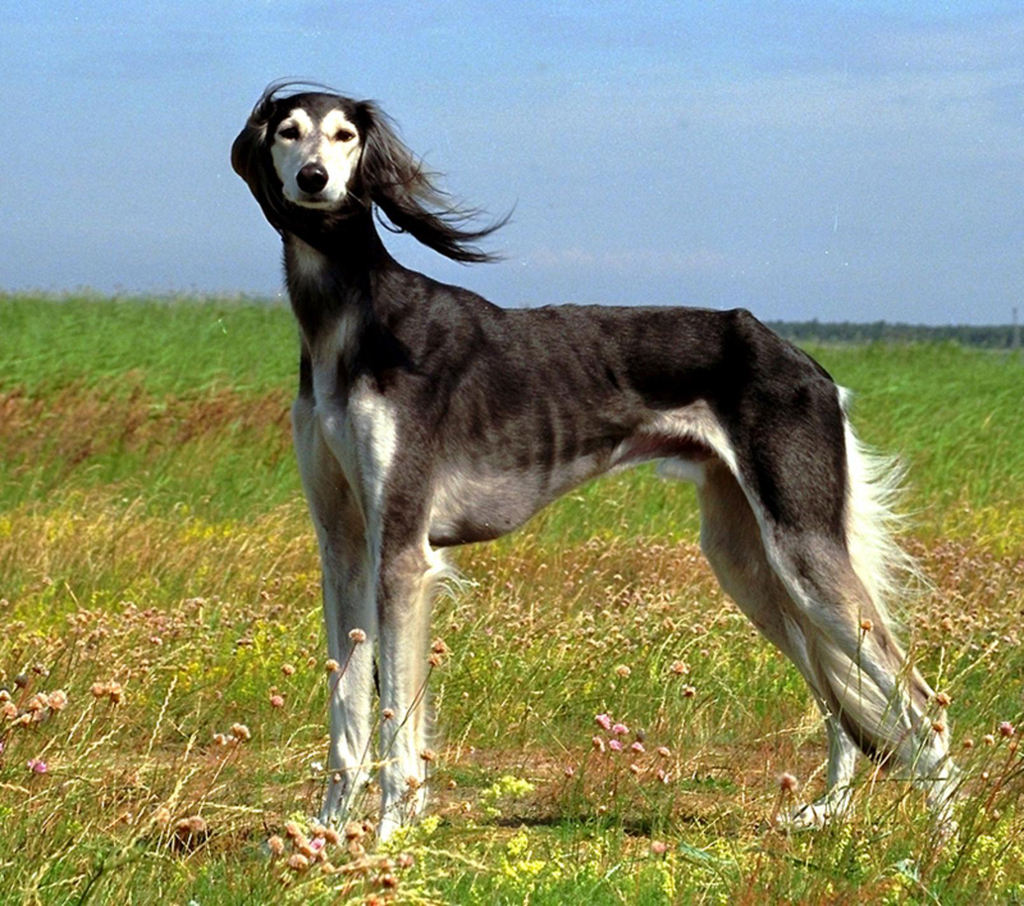
The inherent manners of the Saluki do not allow them to flaunt their feelings. They will not follow the owner on the heels and ask for food or affection, but patiently await his attention. If the animal is left alone for a long time, it will also not show this, but will calm itself down on its own, but at the same time its nervousness will be visible from the gnawed objects and some mess in the house.
The Salukis treat their other relatives with comradely friendliness and will gladly spend time in their company, which cannot be said about cats.Their dogs are perceived as potential prey and no owner's shouts can suppress their natural hunter instinct.
According to experts, Saluki is one of the types of dogs that are difficult to train and train. In infancy, individuals are so stubborn that not every owner is able to endure such a long resistance to education. Usually, by the two-year period, stubbornness is replaced by mercy, and the pet turns into a good-natured and affectionate animal.
By their nature, Salukis are addicted natures, so when going for a walk, you should definitely take their favorite delicacy in case the hunting instincts take over and the dog zealously rushes after another target. It’s the yummy that can bring him back.
In order not to once again injure the weak nervous system of the Salukis, cynologists advise talking to animals when carrying out some new procedure or introducing an unfamiliar training method. They like it very much.
Due to their short coat and lack of body fat, as well as natural cleanliness, Salukis do not need extensive daily grooming. They need to be bathed only once every 2-3 months using very delicate products, since abrasive shampoos can only harm the pet, and then blow-drying.
In terms of health, the Salukis are one of the leaders. All diseases to which these animals are subject due to long-term historical isolation are minimized. The only feature of this type is intolerance to anesthesia, even in small quantities. This can lead to death.
- noble;
- unobtrusive;
- friendly with all family members and relatives;
- good health.
- captivating nature;
- weak nervous system;
- does not tolerate speech in raised tones;
- sensitive to cold and anesthesia;
- poorly trainable.
pharaoh hound
votes 6
This individual is a graceful, graceful creature with a flexible body and majestic posture. The history of its origin goes far into the past and is shrouded in the darkness of a mystery that has not been disclosed so far, but the variety that has survived to the present time has gained its popularity.
The variety standards are:
- height - males from 56 to 63 cm, females from 53 to 61;
- weight, respectively, 30 and 20 kg;
- period of life from 14 to 17 years;
- elongated wedge-shaped head;
- graceful long limbs;
- ears sticking up high;
- large nasal lobe red or flesh-colored;
- eyes of a small shape, expressive with an amber tint;
- thick at the base and tapering towards the end of the tail with a white tip;
- dense, close to the body short hair;
- reddish-brown, red-gold and chestnut coloring;
- possible presence of white spots on the forehead, bridge of the nose and chest.
Individuals of this species are distinguished by openness, friendliness and kindness. Keeping them in a protective or protective capacity will not bring any benefit. Representatives do not show aggression when strangers appear, but they are wary and keep at a remote distance.
Attachment of the species to the owner and members of his family, as well as to small children, occurs very quickly. Taking care of the kids, "pharaohs" actively take part in their games and entertainment. This is due to the natural mind and independence.
The only drawback in the natural genetics of this species is the hunter's instinct, so the attitude towards smaller domestic animals or birds is completely different.If there are “pharaohs” in the house, it is advisable to keep all other representatives of the animal world in cages.
When purchasing a dog of this type, it should be remembered that he needs a house with a local area, and not an apartment or a cramped kennel. Due to the activity and love of outdoor games, limited space will be burdensome and can lead to illness.
Individuals of this species do not require careful care every day. You can forget about combing her hair, since she does not need it, but wiping the dog once a week with a damp cloth is still necessary. Bathing is recommended 1-2 times a year (without the use of shampoos with a chemical composition). A regular procedure is to trim overgrown claws, as they cause pain and discomfort to the pet when walking and running.
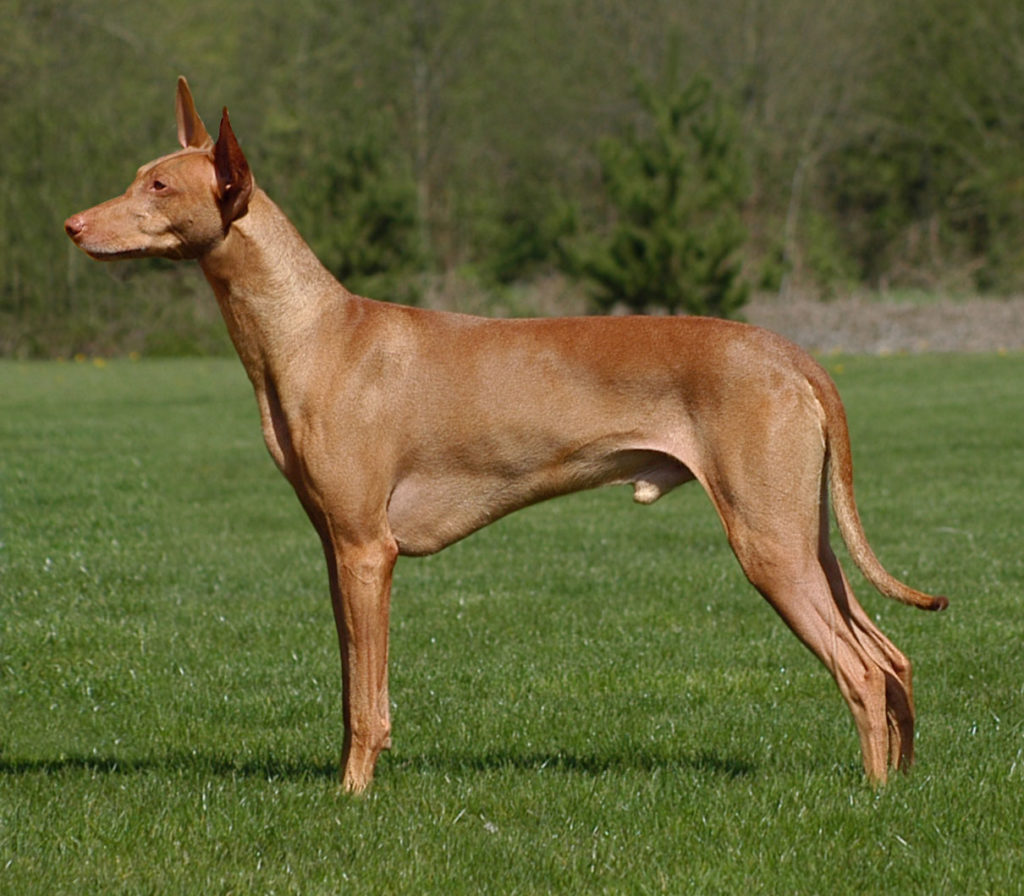
To maintain the shape and health of the "pharaohs", they should organize physical activity in the fresh air for 3 hours. If this is not done, then the dog will become sad, lethargic and will whine for a long time.
Socialization, education and training of puppies should be taught from an early age. Due to their natural timidity and some stubbornness, commands are not always executed the first time, but in no case should you shout or beat the dog. It is enough to slightly raise the tone and the animal immediately understands what is required of it.
"Pharaohs", due to their active lifestyle and good heredity, have good health and a long life, but the wrong diet or exercise can lead to some diseases, such as bloating, hip dysplasia, or dislocation of the kneecaps. That is why it is necessary to carefully monitor the pet's diet and conduct scheduled examinations at the veterinarian in a timely manner.
- kind;
- affectionate;
- non-aggressive;
- get along well with children;
- have good health;
- well trained;
- do not require constant care.
- manifestation of the hunting instinct;
- not intended for keeping in apartments.
chow chow
votes 8
These unusual creatures, similar to teddy bears, are considered one of the most ancient varieties of dogs. Descended from the wild wolf and domesticated by nomads, Chow Chows have evolved into guard and hunting representatives with a proud, independent character. Subsequently, Buddhist monks began to purposefully breed such pets. For a long time they raised individuals of this type, exchanging them between monasteries to improve the breed.
Currently, the standard features of Chow Chow include:
- height from 45 to 55 cm;
- weight from 20 to 30 kg;
- life expectancy from 9 to 15 years;
- powerful skeleton with a straight back and broad chest;
- a flat and wide skull of the head, which abruptly passes from the forehead to the muzzle;
- wide large nose;
- set wide, thick, small, rounded at the ends of the ears with an inclination forward;
- oval eyes of medium size with a dark tint;
- powerful jaws with even teeth having a scissor bite;
- tail set high and close to the back;
- strong, well-developed limbs with cat's paws at the end;
- long or short dense and thick coat 5 colors: white, black, beige, red, blue and cinnamon.
Chow Chows are sedate and self-sufficient creatures that do not show aggression towards strangers, but also do not tolerate encroachments on their personal space. This quality is identical to that of a cat. This type of dog is perfect for calm people with a measured lifestyle.Without showing obvious excessive feelings for the owner, the animal, nevertheless, is very devoted and requires no less attention from him.
Due to their natural neatness, chow chows do not like to get dirty, so care for them consists only of weekly combing of wool, 1 or 2 baths a year and wiping with wet wipes as the areas of wool get dirty.
Feeding pets is desirable to carry out a balanced meal of industrial production. When using natural food, it must be supplemented with vitamins.
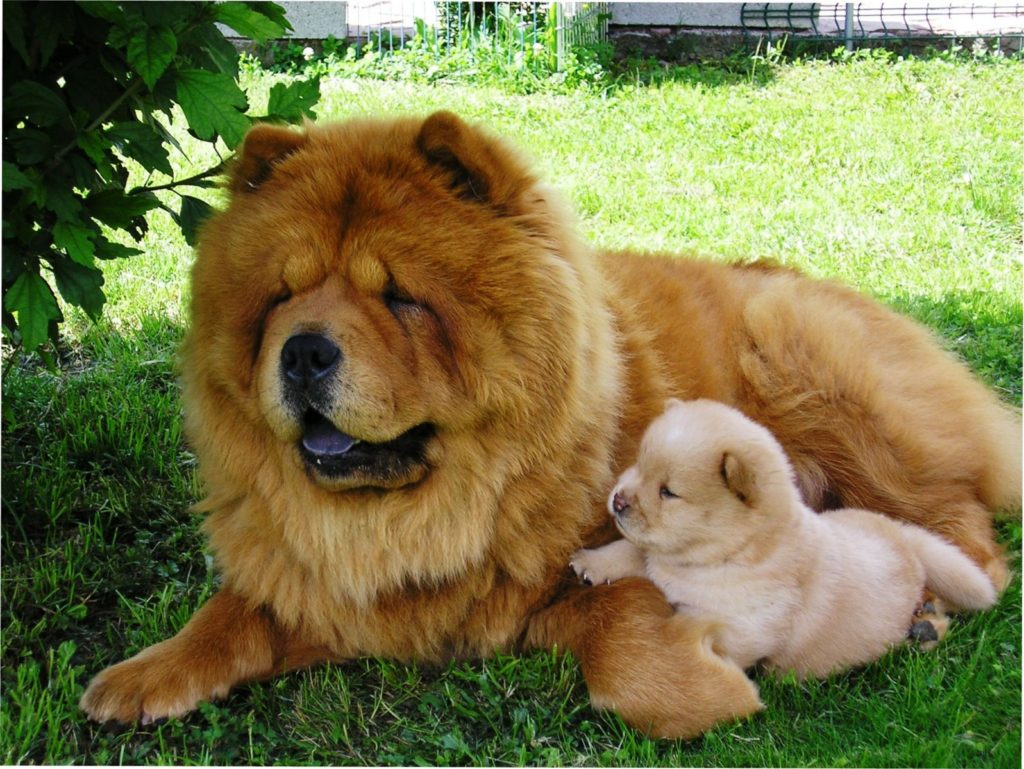
Chow Chows are not athletic dogs, so a leisurely long walk is enough for them.
With a well-established relationship between the pet and the owner, training and training will achieve maximum results. If the relationship is less trusting, then some stubbornness of the Chow Chow can reduce these successes or prolong their achievement in time.
Thanks to strong immunity developed over many millennia, chow chows are distinguished by excellent health and resistance to many diseases, but the only gap in this is the occurrence of an allergic reaction to the bites of various insects. At the first sign of the appearance of such a phenomenon, you should immediately contact your veterinarian.
- balanced;
- calm;
- reserved;
- benevolent;
- require minimal maintenance.
- some stubbornness;
- intolerance to the violation of personal space.
Miniature decorative dogs
lyon bichon
votes 7
Levkhen, as it is also called, is a miniature individual designed to create a decorative home and admire all its inhabitants.Derived from several varieties, these pets have become increasingly popular among modern buyers.
When entering the breed into officially recognized ones, the following standards were determined:
- height from 21 to 33 cm;
- weight from 3 to 6 kg;
- life expectancy from 12 to 14 years;
- a small head with a flattened muzzle;
- medium sized dark eyes;
- short, hanging ears;
- black nose;
- thick, fluffy, long and spiral coat;
- short tail thrown back;
- white, black or spotted.
Cheerful, energetic, friendly and fearless disposition of the Lyon-Bichon will appeal to all members of the family. Children will be delighted with the activity of the pet and his participation in all games and fun without exception.
Despite its small size, the levkhen will furiously rush at an ill-wisher who poses a danger in order to protect its owner.
Due to their natural intelligence, miniature "lion cubs" easily learn new commands during training and follow them with obedience afterwards.
When carrying out nutrition, experts recommend using only specially balanced food of industrial production.
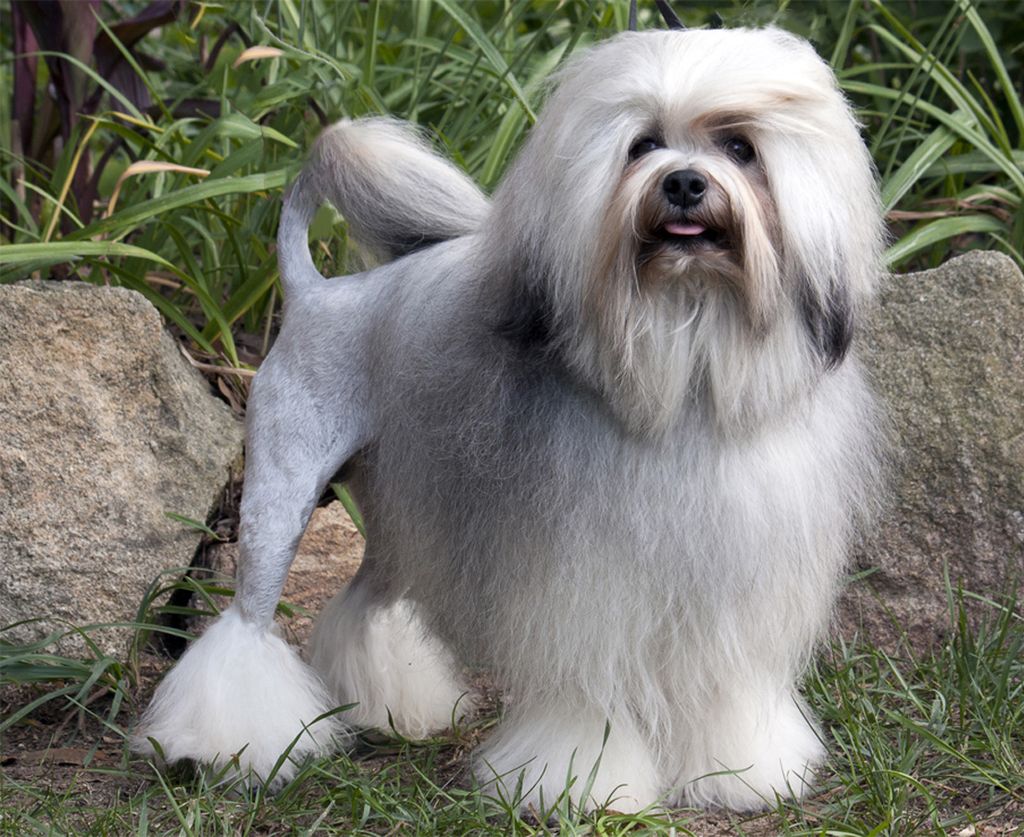
It is necessary to take care of the Bichon Lyon daily, combing out his fluffy coat. Moreover, a puppy should be taught to this procedure from a very early age, so that it eventually becomes a habit. It is also necessary to regularly trim the pet, care for the claws, teeth, oral cavity, eyes and ears.
The versatility of the Levchen breed makes it possible to keep them both in an apartment and in a spacious house. When going for a walk in the winter, it is advisable to warm the pet, as it is prone to hypothermia.
- funny;
- friendly;
- smart;
- easy to train;
- fearless;
- universal.
- requires daily care.
Cavalier King Charles Spaniel
votes 11
These decorative big-eyed cuties have gained particular popularity among lovers of four-legged friends. Being inhabitants of the British nobility, they acquired a semblance of their character. Powerful and balanced spaniels get along well with all the surrounding people and animals.
By standard parameters, these dogs have:
- growth from 25 to 35 cm;
- weighing from 5.4 to 8 kg;
- life expectancy from 10 to 12 years;
- flat head in the ear area;
- small, tapering to the nose, muzzle;
- large, round, bulging and wide-set eyes;
- hanging, high-set ears with long hair;
- even teeth with a scissor bite;
- medium length neck and stretched body;
- small parallel limbs;
- low set tail (often docked);
- long, slightly wavy silky coat;
- black and tan, ruby, tricolor, or blenheim.
The calm, friendly, even-tempered and loyal nature of the spaniel makes them an exceptional choice for families with a moderate lifestyle. Animals easily find common contact with adults, immediately gain mutual understanding with children and other inhabitants of the home. The lack of aggression and natural friendliness does not allow the use of spaniels as guards or defenders, but the dogs will be happy to be able to help the owner during the hunt.
Thanks to their aristocratic character traits, these noble pets will keep company both in a small apartment and in a large country house. The main thing for them is the attention and care of the owner, friend.
In the process of evolution, spaniels have become completely domestic dwellers and calmly spend all their time in a secluded corner with a couch and toys, but the variety’s tendency to accumulate excess weight makes its own adjustments, so they simply need a daily hourly walk in the fresh air. As well as care for long decorative wool. It is desirable to comb it out at least 2 times a week, and bathe only 3 times a year. The rest of the procedures can be entrusted to a specialist or done independently. Experts advise to be especially careful about the eyes, as this is a weak point in the health of this variety.

Unlike many other animal species, spaniels are not stubborn, and their natural obedience ensures that they learn all the necessary commands quickly and effectively.
When purchasing a spaniel puppy, special attention should be paid to the presence of hereditary or congenital diseases, which they are often prone to with improper care and maintenance. If all this is absent, then the pet will delight others with its healthy and friendly presence for many years.
- aristocratic;
- non-aggressive;
- obedient;
- friendly;
- sociable.
- frequent combing;
- a large list of possible diseases.
Conclusion
So, in order to satisfy the desire and acquire a pet that fully corresponds to your lifestyle, activity level, attention and conditions of detention, as well as evaluating your ability to provide the necessary care for him, you can safely go to the nursery for the long-awaited puppy.But, at the same time, one should not forget about the basic standard parameters and features described in the article, so as not to get into trouble and buy a non-purebred representative.
new entries
Categories
Useful
Popular Articles
-

Top ranking of the best and cheapest scooters up to 50cc in 2022
Views: 131652 -

Rating of the best soundproofing materials for an apartment in 2022
Views: 127693 -

Rating of cheap analogues of expensive medicines for flu and colds for 2022
Views: 124520 -

The best men's sneakers in 2022
Views: 124034 -

The Best Complex Vitamins in 2022
Views: 121941 -

Top ranking of the best smartwatches 2022 - price-quality ratio
Views: 114981 -

The best paint for gray hair - top rating 2022
Views: 113396 -

Ranking of the best wood paints for interior work in 2022
Views: 110320 -

Rating of the best spinning reels in 2022
Views: 105330 -

Ranking of the best sex dolls for men for 2022
Views: 104367 -

Ranking of the best action cameras from China in 2022
Views: 102217 -

The most effective calcium preparations for adults and children in 2022
Views: 102012
